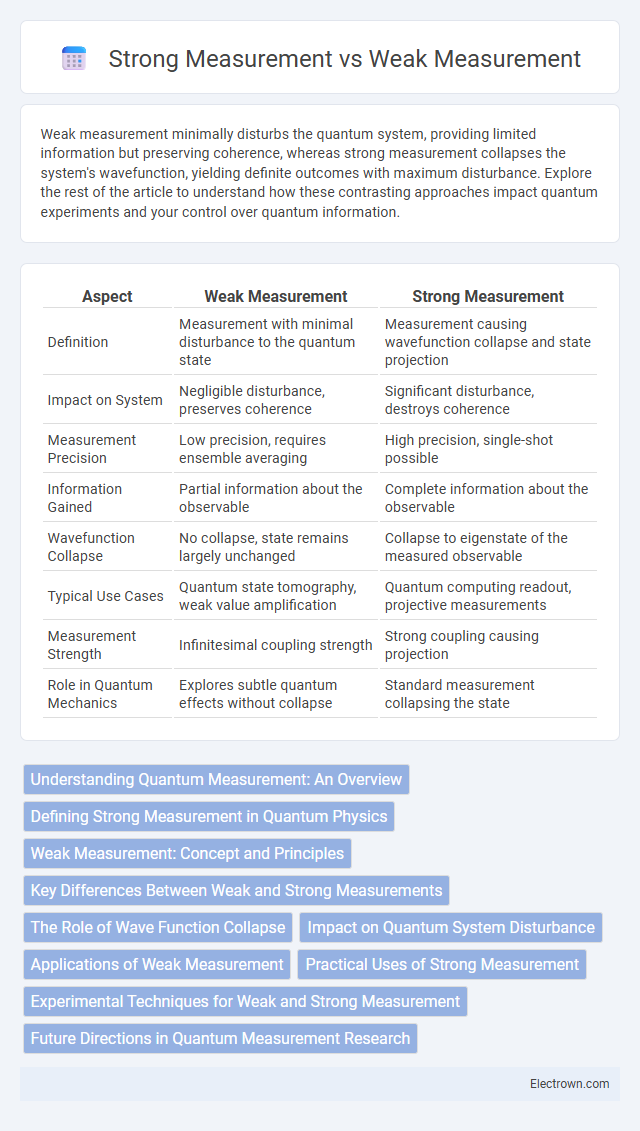Weak measurement minimally disturbs the quantum system, providing limited information but preserving coherence, whereas strong measurement collapses the system's wavefunction, yielding definite outcomes with maximum disturbance. Explore the rest of the article to understand how these contrasting approaches impact quantum experiments and your control over quantum information.
Table of Comparison
| Aspect | Weak Measurement | Strong Measurement |
|---|---|---|
| Definition | Measurement with minimal disturbance to the quantum state | Measurement causing wavefunction collapse and state projection |
| Impact on System | Negligible disturbance, preserves coherence | Significant disturbance, destroys coherence |
| Measurement Precision | Low precision, requires ensemble averaging | High precision, single-shot possible |
| Information Gained | Partial information about the observable | Complete information about the observable |
| Wavefunction Collapse | No collapse, state remains largely unchanged | Collapse to eigenstate of the measured observable |
| Typical Use Cases | Quantum state tomography, weak value amplification | Quantum computing readout, projective measurements |
| Measurement Strength | Infinitesimal coupling strength | Strong coupling causing projection |
| Role in Quantum Mechanics | Explores subtle quantum effects without collapse | Standard measurement collapsing the state |
Understanding Quantum Measurement: An Overview
Quantum measurement involves extracting information from a quantum system, where strong measurement collapses the wavefunction into a definite state, yielding precise outcomes but destroying superpositions. Weak measurement, by contrast, minimally disturbs the system, providing partial information while preserving coherence, which is useful for monitoring quantum dynamics without full collapse. Understanding these measurement types helps optimize your approach to controlling and interpreting quantum experiments.
Defining Strong Measurement in Quantum Physics
Strong measurement in quantum physics involves a projective measurement that collapses the quantum state into an eigenstate of the observed operator, yielding a definite outcome with maximum information gain. This measurement irreversibly disturbs the system, eliminating any superposition and preventing further coherent evolution of the original state. The post-measurement wavefunction corresponds precisely to the eigenvector associated with the observed eigenvalue, ensuring repeatability of subsequent measurements with the same observable.
Weak Measurement: Concept and Principles
Weak measurement involves obtaining limited information about a quantum system with minimal disturbance, preserving its coherence and allowing for the observation of subtle quantum effects. Unlike strong measurement, which collapses the wavefunction and provides definite outcomes, weak measurement yields probabilistic data averaged over many trials, revealing properties like weak values. Your understanding of quantum mechanics benefits from grasping that weak measurement enables the investigation of quantum systems in ways strong measurement cannot, offering insights into superposition and entanglement without destroying the quantum state.
Key Differences Between Weak and Strong Measurements
Weak measurement extracts partial information from a quantum system with minimal disturbance, preserving superposition states and enabling the observation of quantum properties without collapsing the wavefunction. Strong measurement, in contrast, fully collapses the wavefunction, yielding definite eigenvalues while significantly disrupting the system's state. The key differences lie in the trade-off between information gained and system disturbance, with weak measurement providing probabilistic averages and strong measurement delivering precise outcomes.
The Role of Wave Function Collapse
Weak measurement minimally disturbs the quantum system, allowing partial information extraction without fully collapsing the wave function, preserving superposition states. Strong measurement induces a complete wave function collapse, forcing the system into a definitive eigenstate and yielding precise, direct outcomes. Understanding this contrast illuminates how your choice of measurement impacts quantum state evolution and the information obtained.
Impact on Quantum System Disturbance
Weak measurement minimally disturbs the quantum system, allowing for partial information extraction without causing wavefunction collapse, thus preserving coherence and enabling the observation of subtle quantum effects. Strong measurement forces the system into an eigenstate of the observable, causing significant disturbance and irreversibly collapsing the wavefunction. This fundamental difference impacts applications in quantum computing and quantum control, where maintaining system coherence is crucial.
Applications of Weak Measurement
Weak measurement enables precise estimation of quantum states with minimal disturbance, making it ideal for quantum state tomography and error correction in quantum computing. Its ability to amplify subtle signals enhances metrology applications, such as measuring tiny optical phase shifts and improving sensor sensitivity. Your research or technological developments can benefit from weak measurement techniques to achieve higher accuracy and robustness in quantum information processing.
Practical Uses of Strong Measurement
Strong measurement provides definitive results by collapsing the quantum state, making it essential for reliable quantum computing and precision experiments. This method enables exact determination of qubit states, facilitating error correction and algorithm implementation in quantum processors. Your ability to harness strong measurement ensures accurate data extraction critical for advancing quantum technology and experimental validations.
Experimental Techniques for Weak and Strong Measurement
Weak measurement techniques employ minimally invasive interactions that disturb the quantum system insignificantly, using weak coupling between the system and measurement device to extract information without collapsing the wavefunction. Strong measurement methods rely on projective measurements that collapse the quantum state, achieved through strong coupling and subsequent detection, often using photon detectors or superconducting qubits. Experimental setups for weak measurements frequently use interferometric apparatus or post-selection protocols, whereas strong measurements integrate direct detection schemes that provide definitive eigenvalue outcomes.
Future Directions in Quantum Measurement Research
Exploring weak measurement techniques enables researchers to access quantum system information with minimal disturbance, offering promising avenues for enhancing quantum computing and precision metrology. Advances in strong measurement methodologies focus on improving accuracy and reliability in quantum state collapse detection, crucial for fault-tolerant quantum error correction. Your engagement with these developments can contribute to pioneering applications in quantum communication and fundamental physics experiments.
weak measurement vs strong measurement Infographic

 electrown.com
electrown.com